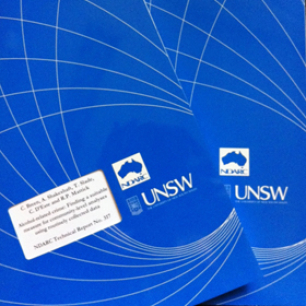NDARC Technical Report No. 271
EXECUTIVE SUMMARY
This report presents the results of the 2006 Illicit Drug Reporting System (IDRS) for the Northern Territory (NT). This is the seventh year that the IDRS has been conducted in the NT.
The IDRS is coordinated by the National Drug and Alcohol Research Centre (NDARC) which is part of the University of NSW. It is jointly funded by the Australian Government Department of Health and Ageing (AGDHA) and by the National Drug Law Enforcement Research Fund (NDLERF).
The IDRS combines data from a survey of injecting drug users (IDU), a survey of key experts (KE) and the collation of illicit drug-related indicator data to monitor the price, purity and availability of a range of illicit drug classes and to identify emerging trends in illicit drug use and the illicit drug market.
Demographic characteristics of injecting drug users
As in previous years, the IDU sample was primarily male (70%), aged in the mid-to-late-thirties (meaN=38 years), spoke English at home and was unemployed (76%). Sixteen percent of the sample identified as Indigenous, 52% had been in prison, and 13% were in treatment at the time of interview.
Patterns of drug use among IDU
The five illicit drugs most commonly used by the IDU sample in the last six months remain unchanged from the previous year: morphine, cannabis, speed powder, benzodiazepines and some form of methadone. Morphine use and injection among the IDU remains stable compared to last year; diverted MS Contin is still the preferred form. Recent speed use and injection is declined slightly while recent use and injection of base, ice/crystal and liquid amphetamine have increased. Recent use and injection of heroin has fluctuated over the last three years with a decline this year. The proportions using and injecting all forms of methadone have decreased this year, although illicit physeptone remains the most commonly used form.
Heroin
- A small number of IDU reported a heroin price of $50 a cap.
- The proportion of IDU reporting recent heroin use has declined, as has the number able to comment on market characteristics.
- ‘rock’ has been the main form of heroin used among IDU for the last three years.
Methamphetamine
- The point prices of base and ice/crystal have increased.
- Base and ice/crystal are reportedly more available and their use among the IDU has increased, as has the use of liquid amphetamines.
- Amphetamine-related harms – including law enforcement and hospital admissions - show increases into 2004/05 (the most recent period available) and are consistent with this year’s key expert comment.
Cocaine
- Cocaine continues to be difficult to obtain and is used by few people in the NT.
Cannabis
- The prices of both hydroponic and bush cannabis have remained stable at $30/$25 per gram and $300/$200 per ounce; it remains easy or very easy to obtain.
- Cannabis use is also stable, being used by most of the IDU sample and by most regular drug users seen by key experts.
- Cannabis-related hospital admissions have increased on last year and show a longer term fluctuating increase.
- Some key experts report an increase in the use of bucket bongs among urban Indigenous and non-Indigenous cannabis users.
Use of other opioids
- The price of illicit morphine is stable at $60 for 100mg, with MS Contin still the most commonly used form.
- Both IDU and key experts report that illicit morphine has become more difficult to obtain although use patterns remain comparable to previous years.
- The use of illicit methadone has reduced this year, although the price – at$1 per ml of methadone syrup and $15 for 10mg of Physeptone - and most popular form (Physeptone) remain stable.
Use of other drugs
- Illicit benzodiazepine is common among IDU and shows an increase over four years as the main from of benzodiazepine use (from 22% of the IDU sample in 2003 to 31% this year); increased use of benzodiazepines among the IDU sample is consistent with key expert reports of it’s profile among the regular drug users they encounter.
- Key experts also raised concerns about the common use of both benzodiazepines and antidepressants among injecting drug users in order to mage the effects of their drug use, particularly anxiety and depression.
- Both key experts reports and the findings of the IDU survey are consistent with an increased presence and use of LSD in the NT.
Associated harms
- The sharing of injection equipment other than needles had increased among the IDU sample.
- Benzodiazepine injection and morphine injection were the behaviours most closely associated with a range of injection-related problems, with the proportions reporting injection-related problems increasing for both drugs.
- Driving risk behaviours were similar to those found in 2005 with just on half the IDU sample driving within an hour of taking an illicit drug, most commonly morphine, cannabis, speed powder and ecstasy.
- About one third of the IDU sample reported becoming verbally aggressive while using or coming down from an illicit drug – most commonly morphine, alcohol, cannabis, benzodiazepines or an amphetamine – and about one in ten becoming physically aggressive.
- The proportion of IDU reporting criminal activity has declined over the past three years - dealing and fraud show longer term downward trends, while violence and property crime have been stable.
Citation: Moon, C. (2007) NT Drug Trends 2006: Findings from the Illicit Drug Reporting System (IDRS). Sydney: National Drug and Alcohol Research Centre.


